How to practice yoga to improve mental health? Have you ever noticed how mentally refreshed and rejuvenated you feel when you practice yoga regularly? Yes, it does reduce stress, leaving us calmer and more relaxed. Yoga is not just another form of exercise. It works on the principles of body-connection, a wholesome practice that enables us to synchronize and harmonize all our aspects, thereby enjoy better quality of life. Before we look into some of the Asanas, Pranayama, and Mudra that could gift us better mental health, let us know how yoga, in general, contributes to our overall well-being.
Yoga to improve mental health
Yoga teaches us to focus more on our parasympathetic system. In simpler words, it helps us to focus more on acceptance rather than practice a flight or fight response. The deep breathing practices enables to develop mindfulness, thus calming our nervous system, in turn, enhancing our mental wellbeing. That’s why we should do practices in yoga to improve mental health.

Yoga could inculcate the concept of mindfulness, the craft of living in the moment. And, when we live in this moment, we are more conscious about what our thoughts are. In turn, we get an opportunity to release criticism and judgment. Being non-judgmental releases stress, thus enhancing focus, concentration, and overall mental health.
It could help you stay grounded and balanced even when turbulent moments strike you. Through the ability to look at the bigger picture with the tool called mindfulness, yoga helps you become a neutral observer, allowing you to accept things as is. This, in turn, could help you assimilate grief, pain, and other emotions and feelings you experience under such moments, enabling you to become stronger and wiser.
Yoga helps enhancing the quality of your relationships. When you are centered and indulge in a better relationship with yourself, you will be able to understand your partner better. This sense of understanding will lift away the pressure from relationships, thereby helping you become more compassionate. When you are in a peaceful and secure relationship, your mental health will also be stable.
7 Practices in Yoga to improve Mental Health
Here is a simple sequence that you can practice daily to boost your mental health.
1. Uttanasana – Standing Forward Fold
Stand with your feet separated as wide as your hips. Roll your shoulders down and away from your ears, allowing the shoulder blades to come into contact, if possible. Let the palms rest on your outer thighs. Engage your abdominal muscles, pulling the navel close to your spine.
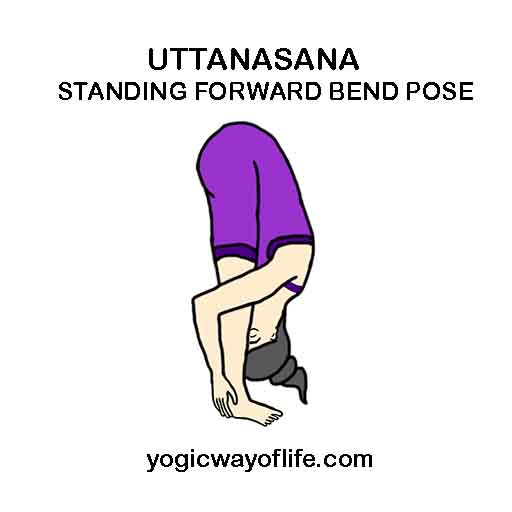
Inhale and lengthen your spine. At the same time, lift your arms to the ceiling. As you exhale, bend forward from your hips and place your palms on either side of your feet. Rest your abdomen on your thighs. Allow the head to hang close to the shin.
Keep your knees slightly bent to keep your lower back safe, especially if you have tight hamstrings. Hold the Asana for the next seven to nine breaths.
2. Adho Mukha Svanasana – Downward Facing Dog Pose
Complete Uttanasana. Inhale, press the palms into the floor, and walk your legs back. Exhale and push the hips to the ceiling. Press the heels to the floor. Adjust the alignment to stack your elbows and shoulders over the wrists. Spread the palms wide, pressing the fingers into the floor. Allow the head to hand between the elbows.
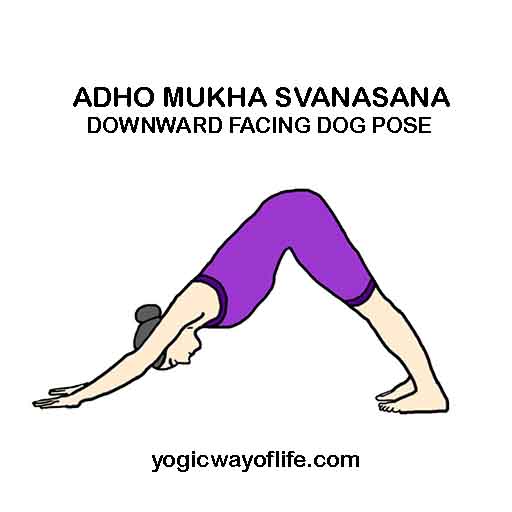
Inhale, squeeze the buttocks, and engage the core muscles, allowing the navel to come close to the spine. Rolling back your shoulders with the exhalation, make final adjustments, allowing your hips rise to the ceiling, and heels move closer to the floor. Hold the Asana for seven to nine breaths.
3. Parivrtta Trikonasana – Revolved Triangle Pose
Complete Adho Mukha Svanasa and take a couple of breaths to prepare your body and mind for the practice. Pressing your palms firmly into the floor, inhale, and lift your left leg up. As you exhale, place the left foot between the palms. Straighten both legs. Do not make any changes to the position of your feet.
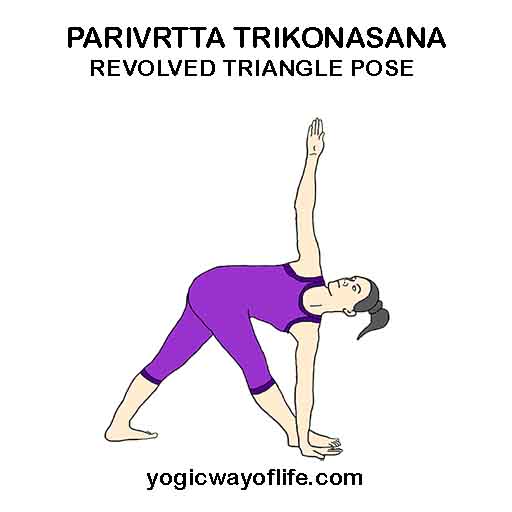
Breathing in and pressing the right palm into the floor, swing your left arm to the ceiling. Simultaneously, twist your torso to the left and gaze up at the left finger tips. Hold the posture for seven to nine breaths.
Inhale and release the left palm. Exhale and place your left leg back and come back into Downward Facing Dog Pose. Repeat on the other side.
4. Prasarita Padottanasana – Wide-Legged Forward Bend
From Downward Facing Dog, gently walk your feet forward and come into Uttanasana. Inhale and slowly roll up to come into Tadasana.
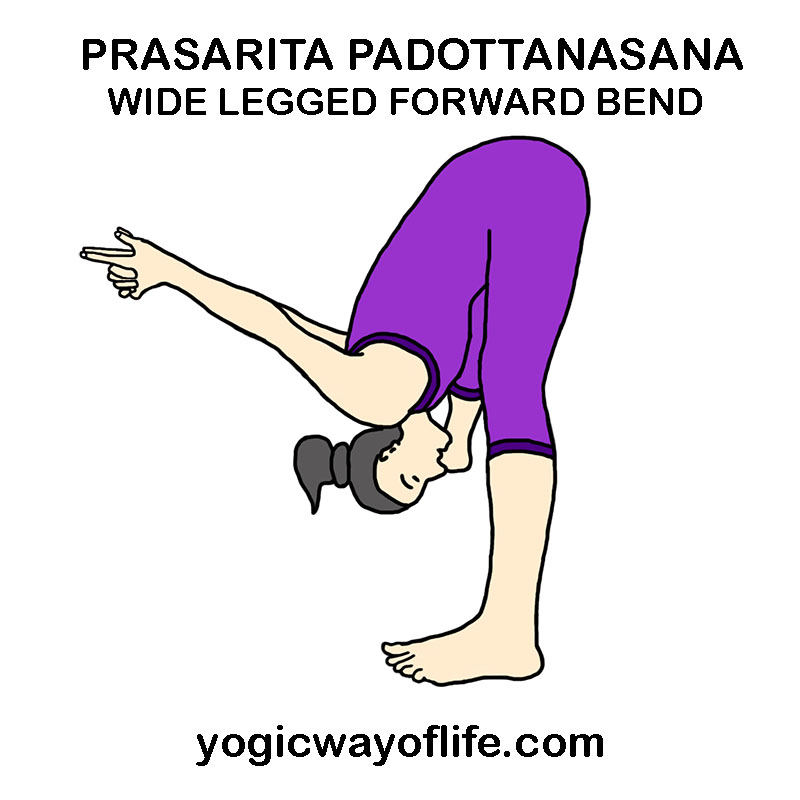
Separate your legs about three to four feet apart. Roll your shoulders down and away from the ears, allowing your shoulder blades to come closer to each other. Lengthen your spine. Pull your abdominal muscles up and close to the spine.
As you inhale, lift your arms up. Breathing out, bend forward from your hips. Push your hips backward and keeping folding forward until your palms rest comfortably on the floor/mat. Keep a tiny bent in your knees to avoid any injuries. Lengthen your spine instead of rounding your back.
Let the head hand between your elbows. Fix your gaze at your navel. With each inhalation, push your hips backward. As you exhale, deepen your fold forward.
Once you reach a comfortable state, hold the posture for seven to nine deep breaths.
5. Shasankasana – Rabbit’s Pose
Complete Prasarita Padottanasana. Gently and carefully, walk your legs close to bring them hip-distance apart. Drop your knees gently down to come into Table Top position.
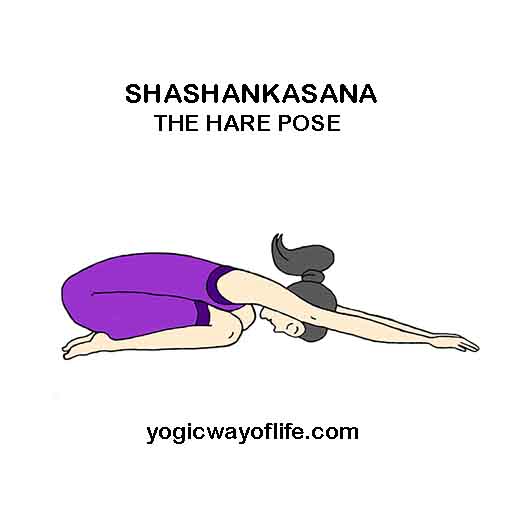
Inhale and sit back into Vajrasana. Exhale here. On the next breath inward, lift your arms up. As you exhale, fold forward. Round your back and rest your forehead on the floor, tucking the chin to the chest. Let the abdomen rest in the space between your thighs. Rest your arms on either side of the body, fingertips extending backward. Alternatively, one could hold the respective heels.
Rest here for seven to nine breaths.
Inhale and roll up gently to come out of the pose.
Lie down in Savasana for the next few minutes, allowing your body to prepare for the Pranayama and Mudra practice.
6. Kapalbhati – Skull Cleansing Breath
Kapalbhati is a powerful breathing technique that involves forceful exhalations. Inhalations are passive. It is advisable to refrain from practicing this breathing technique if you have hypertension or a migraine. Kindly avoid this Pranayama practice if you are pregnant or menstruating.
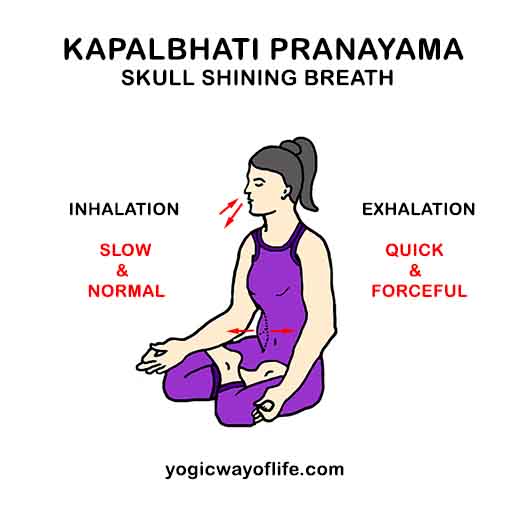
Sit down in comfortable seated posture where your body can remain still and steady for the next couple of minutes. Use a cushion or folded blanket to elevate your hips and maintain an erect spine, and a relaxed belly during the practice.
Roll your shoulders down and away from your ears to open the area around your chest. Tuck your chin. Let the palms rest on your knees. Shape your palm into Gyan mudra, tips of the index finger and thumb in contact. Close your eyes.
Take five to seven rounds of normal breaths to prepare your body and mind for this breathing practice. Take a slow, deep breath in, allowing your chest to expand gently. Practice 15 forceful and steady exhalations. Allow your belly to fall close to the spine with each exhalation. Try not to shake your entire body during the practice, even though the shoulders might move a little due to the force of expulsions.
Once you complete the fifteen expulsions, practice three to five rounds of deep breathing. This completes one round of Kapalbhati.
Pause and feel the impact of the breathing practice. Scan for any sensations you experience in your body and mind. Repeat the practice two more times.
Keep your exhalations steady and powerful. Avoid forced inhalations. Increase the count of expulsions gradually as you master the practice.
7. Buddhi Mudra – The Gesture of Mental Clarity
Buddhi is a Sanskrit word that means intellect or the higher mind. Those who regularly practice this Mudra vouch for its benefits. Practicing Buddhi Mudra on a regular basis could improve your mental clarity, intuitive powers, and psychic abilities. It could also ease anxiety and stress, thereby gifting you better mental health. The Mudra could also in restoring the balance of Water in your body.
The Buddhi Mudra is also known as Jal vardhak mudra and Varuna Mudra.
How to practice Buddhi Mudra
Sit down in a comfortable seated position. Keep your spine erect. Relax your shoulders, but do not slouch. Maintaining your spine long and straight allows the unobstructed flow of energies, enabling you to reap the benefits entirely. Close your eyes.
Stretch out your forearms and rest your palms on your knees. Gently rest the tip of your little finger on the tip of your thumb touch. Exert a slight pressure on the thumb tip. Stretch out the other three fingers. Practice the Mudra for the next 15 minutes.
Yoga Nidra – Mindful Sleep
Yoga Nidra is much more than a restorative practice. It is a conscious and progressive relaxation process that works on releasing stress. Stress, as we all know, is one of the root causes of countless physical and mental health conditions we all are facing today. While there are no known ways to eliminate stress entirely from our lives, through yoga we will be able to reduce its negative impacts to a great extent.
In addition to a consistent yoga practice, consuming healthy foods and taking adequate rest is also essential for boosting mental health. Refraining from junk foods, smoking, and alcohol as well as creating boundaries while indulging in social media are also essential to maintain and enhance your mental health.
This concludes the practices in yoga to improve mental health.

Hari om
Thank you for emailing this document.
Regards
Arun kumar .R